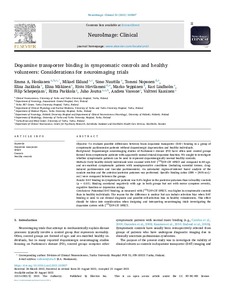Dopamine transporter binding in symptomatic controls and healthy volunteers: Considerations for neuroimaging trials
Joutsa Juho; Lindholm Kari; Scheperjans Filip; Seppänen Marko; Varrone Andea; Eklund Mikael; Honkanen Emma A.; Jaakkola Elina; Mäkinen Elina; Kaasinen Valtteri; Nuuttila Simo; Hirvilammi Risto; Parkkola Riitta; Noponen Tommi
https://urn.fi/URN:NBN:fi-fe2021102752683
Tiivistelmä
Objective
To evaluate possible differences between brain dopamine transporter (DAT) binding in a group of symptomatic parkinsonism patients without dopaminergic degeneration and healthy individuals.
Background
Dopaminergic neuroimaging studies of Parkinson’s disease (PD) have often used control groups formed from symptomatic patients with apparently normal striatal dopamine function. We sought to investigate whether symptomatic patients can be used to represent dopaminergically normal healthy controls.
Methods
Forty healthy elderly individuals were scanned with DAT [123I]FP-CIT SPECT and compared to 69 age- and sex-matched symptomatic patients with nondegenerative conditions (including essential tremor, drug-induced parkinsonism and vascular parkinsonism). An automated region-of-interest based analysis of the caudate nucleus and the anterior/posterior putamen was performed. Specific binding ratios (SBR = [ROI-occ]/occ) were compared between the groups.
Results
DAT binding in symptomatic patients was 8.6% higher in the posterior putamen than in healthy controls (p = 0.03). Binding correlated negatively with age in both groups but not with motor symptom severity, cognitive function or depression ratings.
Conclusions
Putaminal DAT binding, as measured with [123I]FP-CIT SPECT, was higher in symptomatic controls than in healthy individuals. The reason for the difference is unclear but can include selection bias when DAT binding is used to aid clinical diagnosis and possible self-selection bias in healthy volunteerism. This effect should be taken into consideration when designing and interpreting neuroimaging trials investigating the dopamine system with [123I]FP-CIT SPECT.
Kokoelmat
- Rinnakkaistallenteet [19207]
